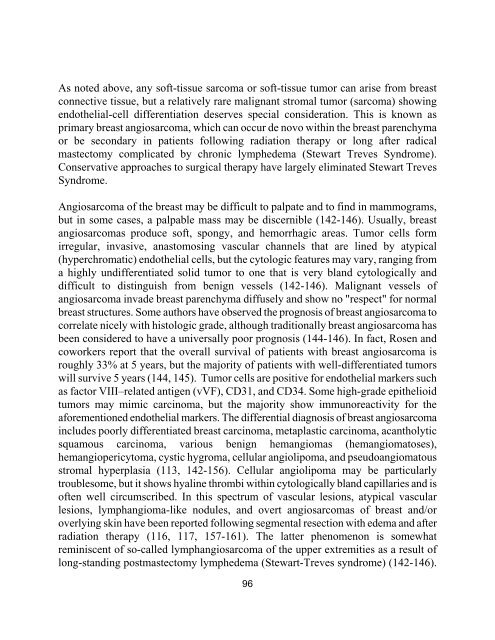33 Special Types of Invasive Breast Carcinoma: Diagnostic Criteria ...
33 Special Types of Invasive Breast Carcinoma: Diagnostic Criteria ...
33 Special Types of Invasive Breast Carcinoma: Diagnostic Criteria ...
You also want an ePaper? Increase the reach of your titles
YUMPU automatically turns print PDFs into web optimized ePapers that Google loves.
As noted above, any s<strong>of</strong>t-tissue sarcoma or s<strong>of</strong>t-tissue tumor can arise from breast<br />
connective tissue, but a relatively rare malignant stromal tumor (sarcoma) showing<br />
endothelial-cell differentiation deserves special consideration. This is known as<br />
primary breast angiosarcoma, which can occur de novo within the breast parenchyma<br />
or be secondary in patients following radiation therapy or long after radical<br />
mastectomy complicated by chronic lymphedema (Stewart Treves Syndrome).<br />
Conservative approaches to surgical therapy have largely eliminated Stewart Treves<br />
Syndrome.<br />
Angiosarcoma <strong>of</strong> the breast may be difficult to palpate and to find in mammograms,<br />
but in some cases, a palpable mass may be discernible (142-146). Usually, breast<br />
angiosarcomas produce s<strong>of</strong>t, spongy, and hemorrhagic areas. Tumor cells form<br />
irregular, invasive, anastomosing vascular channels that are lined by atypical<br />
(hyperchromatic) endothelial cells, but the cytologic features may vary, ranging from<br />
a highly undifferentiated solid tumor to one that is very bland cytologically and<br />
difficult to distinguish from benign vessels (142-146). Malignant vessels <strong>of</strong><br />
angiosarcoma invade breast parenchyma diffusely and show no "respect" for normal<br />
breast structures. Some authors have observed the prognosis <strong>of</strong> breast angiosarcoma to<br />
correlate nicely with histologic grade, although traditionally breast angiosarcoma has<br />
been considered to have a universally poor prognosis (144-146). In fact, Rosen and<br />
coworkers report that the overall survival <strong>of</strong> patients with breast angiosarcoma is<br />
roughly <strong>33</strong>% at 5 years, but the majority <strong>of</strong> patients with well-differentiated tumors<br />
will survive 5 years (144, 145). Tumor cells are positive for endothelial markers such<br />
as factor VIII–related antigen (vVF), CD31, and CD34. Some high-grade epithelioid<br />
tumors may mimic carcinoma, but the majority show immunoreactivity for the<br />
aforementioned endothelial markers. The differential diagnosis <strong>of</strong> breast angiosarcoma<br />
includes poorly differentiated breast carcinoma, metaplastic carcinoma, acantholytic<br />
squamous carcinoma, various benign hemangiomas (hemangiomatoses),<br />
hemangiopericytoma, cystic hygroma, cellular angiolipoma, and pseudoangiomatous<br />
stromal hyperplasia (113, 142-156). Cellular angiolipoma may be particularly<br />
troublesome, but it shows hyaline thrombi within cytologically bland capillaries and is<br />
<strong>of</strong>ten well circumscribed. In this spectrum <strong>of</strong> vascular lesions, atypical vascular<br />
lesions, lymphangioma-like nodules, and overt angiosarcomas <strong>of</strong> breast and/or<br />
overlying skin have been reported following segmental resection with edema and after<br />
radiation therapy (116, 117, 157-161). The latter phenomenon is somewhat<br />
reminiscent <strong>of</strong> so-called lymphangiosarcoma <strong>of</strong> the upper extremities as a result <strong>of</strong><br />
long-standing postmastectomy lymphedema (Stewart-Treves syndrome) (142-146).<br />
96


